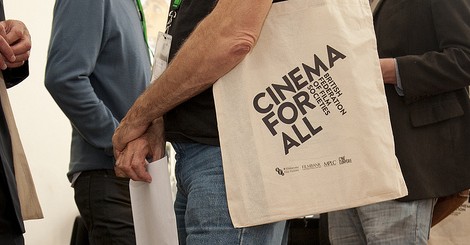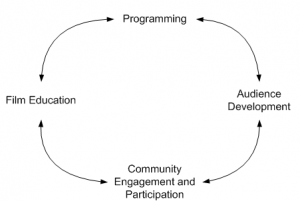
The Participatory Film Society
Imagine this scenario:
And contrast it with this:
There is a trailer for the next film, which was selected by audience votes last month, and then a short 2 min film of two of the elderly residents of the village reminiscing about seeing films in the hall 60 years ago. You watch the main feature; it was a good selection, recommended by a member of the audience, there is applause, and you hand in your audience response slip and help clear up while talking, and then de-camping to the pub. After the lively discussion, a group of you talk with some of the committee about ideas you’ve had for other film-related events, and many of you agree to do some stuff to move the idea forward. You overhear the chair of the parish council talking with another group about ways in which film can be used more widely to promote and develop community engagement, especially with groups in the village who are under-represented in your audience. On the walk home, you check your twitter feeds on your mobile and read the comments about the film, retweet some of them, and respond to others. Just as you get home, the audience reaction score has been posted to Facebook and there’s already been a busy discussion among those who didn’t stay at the pub. Too tired to add anything now, you contribute in the morning, then go and get the paper where you see some of the others who were at the film last night and talk. Some other friends join you; they don’t go to the films, but you explain how good the evenings are, and how welcoming and fun it is. They remember that a cousin is a DP and you make a mental note to tell that to a committee member in case they could be invited along for some film education activity.
And this is just the beginning. As a film exhibition organisation, we can do much more than show films and, in doing so, develop greater personal relevance to our community, and help to make people connect and thrive.[1]
This is the first of a series of articles, completely inspired by a reading of Nina Simon’s fantastic book The Participatory Museum, and her Museum 2.0 blog. The notes in these articles were a result of riffing on the ideas in that book, so I’d recommend you buy a copy right now and start thinking up your own interesting parallels and analogies between museums and film venues. I don’t believe I’ve completely realised the significance and connections of everything Nina has written for our sector, but it feels too important to let it linger only in my head.
So, where to start?
“A participatory institution is a place where visitors can create, share, and connect with each other around content” [2]
Traditionally, community cinema committees or a designated film programmer selects the films and (ideally) people turn up; ie, we provide the content. In the participatory universe, we provide the space and support, and more magic can happen.
Participation isn’t just about getting people to turn up and watch a film. Developed effectively with sensible objectives, participation feeds audience development, film education, community cohesion and engagement.
Over time, it develops a virtuous circle, much like the one I sketched at the BFFS conference two years ago (above). As a result, everything you do supports and enhances other activities. It also spreads the load by subtly getting everyone to support and promote what you are doing while benefiting themselves. The trick is in finding easy wins and ways in which almost any activity can be modified to be of mutual benefit to the organisation and to every individual in the audience.
This can be by:
- Making the community cinema relevant to everyone’s life
- Keeping it alive and changing
- Ensuring everyone’s voices are heard and reflected
- Encouraging creativity
- Making it a comfortable and welcoming place
So, how do we do that? In the next post, we’ll consider the types of participation that we currently have from our community, and start to think about how we can begin to make it better. At the end, you can find all the items by looking at the participatory film society tag.
- Nina Simon. “Do You Have a Good Argument for Your Institution?” Museum 2.0. 25 October 2011. http://museumtwo.blogspot.co.uk/2011/10/do-you-have-good-argument-for-your.html
- Nina Simon. “The Participatory Museum.” Slideshare. 12 August 2010. http://www.slideshare.net/ninaksimon/the-participatory-museum-long-presentation






[…] you can try and get interested members of your film society to write them, furthering the participatory nature of your […]